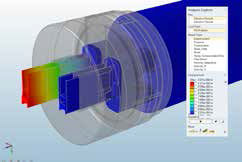Editor’s Pick: Simulate Metal and Polymer Extrusions on the Shop Floor

This screen shot shows the post-processing of extrusion results using HyperXtrude for Metals. Image courtesy of Altair Engineering, Inc.
Latest News
December 10, 2014
 Dear Desktop Engineering Reader:
Dear Desktop Engineering Reader:
 Altair Engineering recently announced the 2015 version of its HyperXtrude manufacturing solution. This is a noteworthy release for a number of reasons. Here are a few. But first, a little background if it’s new to you.
Altair Engineering recently announced the 2015 version of its HyperXtrude manufacturing solution. This is a noteworthy release for a number of reasons. Here are a few. But first, a little background if it’s new to you.
HyperXtrude has been field-tested and industry-driven since 1999. Its basic goal is to help you reduce the need for expensive die trials and minimize product defects by giving you the ability to analyze and optimize extrusion dies as well as process conditions. The best way to envision how this simulator works is to think of it as being a simulation environment that creates a virtual press. With it, you can watch material flows inside your press, analyze heat transfer inside a die during extrusion, and make changes to balance flow and minimize defects.
So, now say that you work at a company that does extrusion processing, either with polymers or metals. You know the scene: You have to generate a more extensive mix of complex profiles in less time and under tight budgets to keep production costs as low as possible without compromising quality. The obvious question is: What’s in HyperXtrude 2015 for me that can help me get the job done under these pressures? The short answer is that version 2015 introduces a new CAD interface for HyperXtrude that lets you set up a model in a CAD-like environment. And what this means is that die designers, engineers and manufacturing experts on the shop floor can validate die designs using CAE techniques directly from CAD models. Oh, and it should also make communication among all those departments much clearer.
This is not just dumping CAE down onto new users without a lot of FEA (finite element analysis) training. You see, the key to this is that Altair’s new analysis approach automates and hides the meshing and data deck creation, placing it in the background. This means that new users, even those lacking in-depth FEA competency, can use the tool to validate and optimize their die designs because they do not have to spend much time learning the software or modeling.
The potential here to streamline workflows while minimizing pricey and time-demanding trials is enormous. Altair says that this new approach can be used to complete pre-processing in just 15 minutes, where previously it may have taken an expert two to four hours to mesh a model.
HyperXtrude 2015 comes with Simplify/Patch tools so that you can clean up geometry problems before running the analysis. Version 2015 also has tools for measurement and mass calculations as well as support for different unit systems.
Existing users will be interested to learn that both metal and polymer extrusions can now work with large models of up to 4 million nodes on either Windows or Linux 64-bit platforms. For metal extrusions, users of version 2015 can now mesh a model with the mandrel offset and the solver will account for this step in the computation, which could save you a lot of time doing CAD corrections. Miscellaneous enhancements include improved solver accuracy for cone prediction of profiles, a new dynamic recrystallization grain size model that accounts for the dependency of grain size on strain and an automatic billet creation option for determining a billet center from a die surface or edge.
For polymer extrusions, HyperXtrude 2015 introduces a new cleanup option that removes unwanted edges and sliver surfaces, which should diminish model cleanup time. You can now improve mesh quality by remeshing the solids based on the initially generated mesh. The Tire Extrusion Wizard’s model-setup feature will now create geometry based on a given die configuration or user-specified solids. This feature supports multi-cut extrusion dies, and specification of tread and die contours as symmetric or full contours.
You can begin to learn more about HyperXtrude 2015 for today’s Pick of the Week write-up. Make sure to take in the overview video to see what’s in it for you if you’re new to HyperXtrude and some of the goodies waiting in store for you current users.
Thanks, Pal. — Lockwood
Anthony J. Lockwood
Editor at Large, Desktop Engineering
Read today’s pick of the week write-up.
This is sponsored content. Click here to see how it works.
Subscribe to our FREE magazine, FREE email newsletters or both!
Latest News
About the Author
Anthony J. Lockwood is Digital Engineering’s founding editor. He is now retired. Contact him via [email protected].
Follow DE





